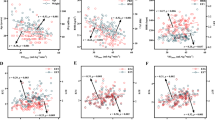Summary
Maximum oxygen uptake\(\left( {\dot V_{{\text{O}}_{{\text{2max}}} } } \right)\) was measured directly and predicted from cardiac frequency measurements in 54 healthy Chilean industrial workers aged 20 to 55 years, together with assessment of their dietary intake, body compositon and blood chemistry. Measurement of\(\dot V_{{\text{O}}_{\text{2}} } \) was performed on a motor-driven treadmill. The predicted was obtained using a cycle ergometer by two methods: 1) the Astrand-Ryhming nomogram and 2) the linear relationship between “steady state” heart rate (HR) and submaximum work, with subsequent extrapolation to “maximum” heart rate. Extrapolation of the HR/load regression line to 170 bpm permitted determination of the physical working capacity at 170 bpm (W170).\(\dot V_{{\text{O}}_{{\text{2max}}} } \) for the 20–29 year group (Group I) averaged 3624 ml · min−1 and decreased to 3066 ml · min−1 in the 50–55 year group (Group IV). Lower values were obtained using the Astrand-Ryhming nomogram and HR/load regression (-15% and -9% respectively). W170 was also affected by age (Group I: 190.6 W and Group IV: 158.5 W). No significant correlation were found between\(\dot V_{{\text{O}}_{{\text{2max}}} } \) and plasma variables, with the exception of cholesterol (r=0.59). On the contrary, anthropometric variables showed significant correlations with\(\dot V_{{\text{O}}_{{\text{2max}}} } \), which permitted the prediction of\(\dot V_{{\text{O}}_{{\text{2max}}} } \) using multiple regression equations. The two best correlations were:
where A=years of age; W=body weight in kg; H=height in m and LBM=lean body mass in kg.
Similar content being viewed by others
References
Allard C, Goulet C (1967) Physical working capacity, blood lipids, and uric acid. Forsvarsmedicin 3:203–205
Allard C, Goulet C (1967) Physical working capacity in a French-Canadian population. An epidemiological study. Forsvarmedicin 3:209–220
Anderson HT, Barkven H (1970) Iron deficiency and muscular work performances. J Clin Lab Invest 25:1–62
Apud E, Donoso H (1984) Prediction of maximal oxygen uptake from age, some anthropometric dimensions, and body composition (Spanish). Arch Soc Chilena Med Deporte 29:34–37
Areskorg NH, Selinus R, Vahlquist B (1969) Physical work capacity and nutritional status in Ethiopien male children and young adultes. Am J Clin Nutr 22:471–479
Arteaga A, Donoso H, Rosales E, Urteaga C, Apud E (1971) Relation between nutritional status and physical working capacity (Spanish). Rev Med Chile 99:904–908
Astrand P-O (1952) Experimental studies of physical working capacity in relation to sex and age. E Munkskard, Copenhagen
Astrand P-O (1971) Definitions, testing procedures, accuracy, and reproduceability. Acta Paediat Scand [Suppl] 217:9–12
Astrand P-O (1976) Quantification of physical working capacity and evaluation of physical capacity in man. Progress Cardiovasc Dis 19:51–67
Astrand P-O, Rodahl K (1977) Textbook of work physiology. Physiological bases of exercise. McGraw-Hill, New York, pp 353–354
Basta SS, Soekirman D, Karyadi D, Scrimsaw NS (1979) Iron deficiency anemia and the productivity of adult males in Indonesia. Am J Clin Nutr 32:916–925
Barac-Nieto M, Spurr GB, Dahners HW, Maksud MG (1980) Aerobic work capacity and endurance during nutritional repletion of severely undernourished men. Am J Clin Nutr 33:2268–2275
Bruce RA (1984) Exercise, functional aerobic capacity, and aging-another viewpoint. Med Sci Sports Exerc 16:8–13
Consolazio CF, Johnson RE, Pecora LJ (1963) Physiologial measurements of metabolic functions in man. McGraw-Hill, New York
Davies CTM (1968) Limitations to the prediction of maximum oxygen intake from cardiac frequency measurements. J Appl Physiol 24:700–706
Donoso H, Apud E, Sanudo MC, Santolaya R (1971) Aerobic capacity as an index of physical fitness in population samples (urban and high altitude dwellers), and in a group of elite athletes (Spanish). Rev Med Chile 99:719–731
Donoso H, Apud E, Lundgren NPV (1971a) Direct estimation of circulatory fatigue using a bicycle ergometer. Ergonomics 14:53–60
Donoso H, Walter T, Nunez S, Chadud P, Stekel A (1984) Effect of therapy in physical work capacity of iron deficient female athletes: A double blind, randomized, controlled study. Fed Proc 43:3
Durnin JVGA, Womersley J (1974) Body fat assessed from total body density and its estimation from skinfold thickness: measurements on 481 men and women aged from 16 to 72 years. Br J Nutr 32:77–87
Exercise Tests in Relation to Cadiovascular Function (1968) Report of a WHO Meeting. Wld Hlth Org Rep Ser No. 388, Geneve
Jelliffe D (1966) The assessment of the nutritional status of the community. WHO, Geneve
Knuttgen HG (1969) Physical working capacity and physical performance. Med Sci Sports 1:1–8
Maksud MG, Supurr GB, Barac-Nieto M (1976) The aerobic power of several groups of laborers in Colombia and the United States. Eur J Appl Physiol 35:173–182
Rowell LB, Taylor HL, Wang Y (1964) Limitations to prediction of maximal oxygen intake. J Appl Physiol 19:919–927
Rowell LB (1974) Human cardiovascular adjustements to exercise and thermal stress. Physiol Rev 54:159
Scherrer J (1981) Precis de Physiologie du Travail. Masson 2nd Edition, Paris
Shephard RJ, Allen C, Brenade AJS, Davies CTM, di Prampero PE, Hedman R, Merriman JE, Myhre K, Simmons R (1968) The maximum oxygen intake. An Int Reference Standard of cardiorespiratory finess. Bull Wld Hlth Org 38:757–764
Teillac A, Camus F, Chaussain M, Sanchez J, Monod H (1975) Comparaison des estimations de la capacité aerobic maximale obtenues par différentes méthodes. Travail Humain 38:325–331
Wahlund H (1948) Determination of physical working capacity. Acta Med Scand [Suppl] 215
Weiner JS, Lourrie JA (1969) A guide to field methods. IBP Handbook No. 9 Blackwell, Oxford
Wyndham CH (1973) The working capacity of rural and urban Bantu in South Africa. S Afr Med J 47:1239–1244
Author information
Authors and Affiliations
Rights and permissions
About this article
Cite this article
Sánchez, J., Donoso, H. Maximal oxygen uptake in Chilean workers of normal nutritional status. Europ. J. Appl. Physiol. 57, 26–32 (1988). https://doi.org/10.1007/BF00691233
Accepted:
Issue Date:
DOI: https://doi.org/10.1007/BF00691233




